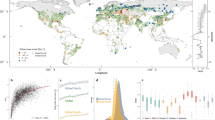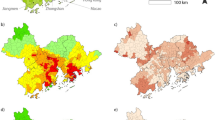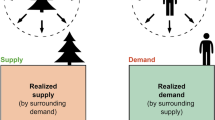Abstract
Climate change adaptation efforts are challenged by rapid population ageing and thus an increased proportion of vulnerable individuals. Despite its importance for adaptation planning, the link between ageing demographics and climate adaptation, particularly green infrastructure development, remains unexplored. Here we employ high-resolution satellite images and the difference-in-differences framework to assess the spatiotemporal relationship between ageing demographics and green space coverage change patterns across 26,885 Southeast Asian communities over the past two decades. We find that cities with an increased concentration of elderly residents exhibit greater vulnerability due to inadequate green infrastructure provision. The findings reveal green space reduction in ageing communities, which is more pronounced in socio-economically disadvantaged, rapidly ageing cities. Nonetheless, coastal cities, facing higher climate risks, exhibit no such decline due to their functional demand. Our results support considering socio-demographic shifts and geospatial disparities in city adaptation strategies.
This is a preview of subscription content, access via your institution
Access options
Access Nature and 54 other Nature Portfolio journals
Get Nature+, our best-value online-access subscription
$29.99 / 30 days
cancel any time
Subscribe to this journal
Receive 12 print issues and online access
$209.00 per year
only $17.42 per issue
Buy this article
- Purchase on Springer Link
- Instant access to full article PDF
Prices may be subject to local taxes which are calculated during checkout


Similar content being viewed by others
Data availability
The data used for this study can be accessed via figshare at https://doi.org/10.6084/m9.figshare.25331881.v1 (ref. 73).
References
IPCC Climate Change 2022: Impacts, Adaptation, and Vulnerability (eds Pörtner, H.-O. et al.) (Cambridge Univ. Press, 2022).
Berrang-Ford, L. et al. Tracking global climate change adaptation among governments. Nat. Clim. Change 9, 440–449 (2019).
Frantzeskaki, N. et al. Nature-based solutions for urban climate change adaptation: linking science, policy, and practice communities for evidence-based decision-making. BioScience 69, 455–466 (2019).
Jorgenson, A. K. et al. Social science perspectives on drivers of and responses to global climate change. WIREs Clim. Change 10, e554 (2019).
Füssel, H.-M. & Klein, R. J. Climate change vulnerability assessments: an evolution of conceptual thinking. Clim. Change 75, 301–329 (2006).
Jarzebski, M. P. et al. Ageing and population shrinking: implications for sustainability in the urban century. NPJ Urban Sustain. https://doi.org/10.1038/s42949-021-00023-z (2021).
Thomas, K. et al. Explaining differential vulnerability to climate change: a social science review. WIREs Clim. Change 10, e565 (2019).
Gamble, J. L. et al. Climate change and older Americans: state of the science. Environ. Health Perspect. 121, 15–22 (2013).
Li, T. et al. Aging will amplify the heat-related mortality risk under a changing climate: projection for the elderly in Beijing, China. Sci. Rep. 6, 28161 (2016).
Molinsky, J. & Forsyth, A. Climate change, aging, and well-being: how residential setting matters. Hous. Policy Debate 33, 1029–1054 (2022).
Huang, C. et al. Mortality burden attributable to heatwaves in Thailand: a systematic assessment incorporating evidence-based lag structure. Environ. Int. 121, 41–50 (2018).
Dang, T. N. et al. Effects of extreme temperatures on mortality and hospitalization in Ho Chi Minh City, Vietnam. Int. J. Environ. Res. Public Health 16, 432 (2019).
Gray, J., Lloyd, S., Healey, S. & Opdyke, A. Urban and rural patterns of typhoon mortality in the Philippines. Prog. Disaster Sci. 14, 100234 (2022).
Sahani, M. et al. A case-crossover analysis of forest fire haze events and mortality in Malaysia. Atmos. Environ. 96, 257–265 (2014).
Gosling, S. N., Lowe, J. A., McGregor, G. R., Pelling, M. & Malamud, B. D. Associations between elevated atmospheric temperature and human mortality: a critical review of the literature. Climatic Change 92, 299–341 (2009).
Bunker, A. et al. Effects of air temperature on climate-sensitive mortality and morbidity outcomes in the elderly; a systematic review and meta-analysis of epidemiological evidence. eBioMedicine 6, 258–268 (2016).
Mora, C. et al. Global risk of deadly heat. Nat. Clim. Change 7, 501–506 (2017).
Dong, Z. et al. Heatwaves in Southeast Asia and their changes in a warmer world. Earth’s Future 9, e2021EF001992 (2021).
Social Policies Catalogue on Population Ageing: A Rapid Scoping Review (UNFPA, 2020).
Hunter, L. M. et al. Scales and sensitivities in climate vulnerability, displacement, and health. Popul. Environ. 43, 61–81 (2021).
Rhoades, J. L., Gruber, J. S. & Horton, B. Developing an in-depth understanding of elderly adult’s vulnerability to climate change. Gerontologist 58, 567–577 (2017).
Sturiale, L. & Scuderi, A. The role of green infrastructures in urban planning for climate change adaptation. Climate 7, 119 (2019).
Goodwin, S., Olazabal, M., Castro, A. J. & Pascual, U. Global mapping of urban nature-based solutions for climate change adaptation. Nat. Sustain. 6, 458–469 (2023).
Matsler, A. M., Meerow, S., Mell, I. C. & Pavao-Zuckerman, M. A. A ‘green’ chameleon: exploring the many disciplinary definitions, goals, and forms of “green infrastructure”. Landsc. Urban Plan. 214, 104145 (2021).
Nieuwenhuijsen, M. J. Green infrastructure and health. Annu. Rev. Public Health 42, 317–328 (2021).
Meerow, S. & Newell, J. P. Spatial planning for multifunctional green infrastructure: growing resilience in Detroit. Landsc. Urban Plan. 159, 62–75 (2017).
Demuzere, M. et al. Mitigating and adapting to climate change: multi-functional and multi-scale assessment of green urban infrastructure. J. Environ. Manage. 146, 107–115 (2014).
Matthews, T., Lo, A. Y. & Byrne, J. A. Reconceptualizing green infrastructure for climate change adaptation: barriers to adoption and drivers for uptake by spatial planners. Landsc. Urban Plan. 138, 155–163 (2015).
Hansen, R. & Pauleit, S. From multifunctionality to multiple ecosystem services? A conceptual framework for multifunctionality in green infrastructure planning for urban areas. Ambio 43, 516–529 (2014).
Ge, F. et al. Risks of precipitation extremes over Southeast Asia: does 1.5 °C or 2 °C global warming make a difference? Environ. Res. Lett. https://doi.org/10.1088/1748-9326/aaff7e (2019).
Ge, F., Zhu, S., Luo, H., Zhi, X. & Wang, H. Future changes in precipitation extremes over Southeast Asia: insights from CMIP6 multi-model ensemble. Environ. Res. Lett. https://doi.org/10.1088/1748-9326/abd7ad (2021).
Sun, X., Ge, F., Fan, Y., Zhu, S. & Chen, Q. Will population exposure to heat extremes intensify over Southeast Asia in a warmer world? Environ. Res. Lett. https://doi.org/10.1088/1748-9326/ac48b6 (2022).
Sietsma, A. J., Ford, J. D., Callaghan, M. W. & Minx, J. C. Progress in climate change adaptation research. Environ. Res. Lett. 16, 054038 (2021).
Varquez, A. C. G., Darmanto, N. S., Honda, Y., Ihara, T. & Kanda, M. Future increase in elderly heat-related mortality of a rapidly growing Asian megacity. Sci. Rep. 10, 9304 (2020).
Implementing a Green Recovery in Southeast Asia Report No. 9292695096 (Asian Development Bank Institute, 2022).
Le, T. D. N. Climate change adaptation in coastal cities of developing countries: characterizing types of vulnerability and adaptation options. Mitig. Adapt. Strateg. Glob. Change 25, 739–761 (2020).
Regional Framework on Healthy Ageing (2018–2022) Report No. 9789290226154 (World Health Organization, Regional Office for South-East Asia, 2018).
Asia-Pacific Report on Population Ageing 2022: Trends, Policies and Good Practices Regarding Older Persons and Population Ageing (UN ESCAP, 2022).
Mortreux, C. & Barnett, J. Adaptive capacity: exploring the research frontier. WIREs Clim. Change 8, e467 (2017).
Kim, S. K., Bennett, M. M., van Gevelt, T. & Joosse, P. Urban agglomeration worsens spatial disparities in climate adaptation. Sci. Rep. 11, 8446 (2021).
Wu, L., Kim, S. K. & Lin, C. Socioeconomic groups and their green spaces availability in urban areas of China: a distributional justice perspective. Environ. Sci. Policy 131, 26–35 (2022).
Chen, W. Y. & Wang, D. T. Economic development and natural amenity: an econometric analysis of urban green spaces in China. Urban For. Urban Green. 12, 435–442 (2013).
Dobbs, C., Nitschke, C. & Kendal, D. Assessing the drivers shaping global patterns of urban vegetation landscape structure. Sci. Total Environ. 592, 171–177 (2017).
Garcia-Lamarca, M. et al. Urban green boosterism and city affordability: for whom is the ‘branded’ green city? Urban Stud. 58, 90–112 (2021).
Richards, D. R., Passy, P. & Oh, R. R. Y. Impacts of population density and wealth on the quantity and structure of urban green space in tropical Southeast Asia. Landsc. Urban Plan. 157, 553–560 (2017).
Wolch, J. R., Byrne, J. & Newell, J. P. Urban green space, public health, and environmental justice: the challenge of making cities ‘just green enough’. Landsc. Urban Plan. 125, 234–244 (2014).
Glaeser, E. Cities, productivity, and quality of life. Science 333, 592–594 (2011).
Estoque, R. C. et al. The future of Southeast Asia’s forests. Nat. Commun. 10, 1829 (2019).
Sodhi, N. S. et al. The state and conservation of Southeast Asian biodiversity. Biodivers. Conserv. 19, 317–328 (2010).
Providing Income Security for the Elderly (UN ESCAP, 2013).
Mather, M. & Scommegna, P. How neighborhoods affect the health and well-being of older Americans. Today’s Res. Aging 35, 1–11 (2017).
Luís, S., Vauclair, C.-M. & Lima, M. L. Raising awareness of climate change causes? Cross-national evidence for the normalization of societal risk perception of climate change. Environ. Sci. Policy 80, 74–81 (2018).
Mears, M., Brindley, P., Maheswaran, R. & Jorgensen, A. Understanding the socioeconomic equity of publicly accessible greenspace distribution: the example of Sheffield, UK. Geoforum 103, 126–137 (2019).
Wüstemann, H., Kalisch, D. & Kolbe, J. Access to urban green space and environmental inequalities in Germany. Landsc. Urban Plan. 164, 124–131 (2017).
Sulla-Menashe, D., Gray, J. M., Abercrombie, S. P. & Friedl, M. A. Hierarchical mapping of annual global land cover 2001 to present: the MODIS Collection 6 Land Cover product. Remote Sens. Environ. 222, 183–194 (2019).
Peng, J., Zhao, M., Guo, X., Pan, Y. & Liu, Y. Spatial–temporal dynamics and associated driving forces of urban ecological land: a case study in Shenzhen City, China. Habitat Int. 60, 81–90 (2017).
Salhab, M. & Basiri, A. Spatial data quality evaluation for land cover classification approaches. ISPRS Ann. Photogramm. Remote Sens. Spat. Inf. Sci. 3, 681–687 (2020).
Pezzulo, C. et al. Sub-national mapping of population pyramids and dependency ratios in Africa and Asia. Sci. Data 4, 170089 (2017).
Kumar, M. D. et al. A framework for risk-based assessment of urban floods in coastal cities. Nat. Hazards 110, 2035–2057 (2022).
Hinkel, J. “Indicators of vulnerability and adaptive capacity”: towards a clarification of the science–policy interface. Glob. Environ. Change 21, 198–208 (2011).
Knapp, K. R. et al. International Best Track Archive for Climate Stewardship (IBTrACS) Project Version 3 (NOAA National Centers for Environmental Information, 2018); https://doi.org/10.7289/V5NK3BZP
Feindouno, S., Guillaumont, P. & Simonet, C. The physical vulnerability to climate change index: an index to be used for international policy. Ecol. Econ. 176, 106752 (2020).
Adler, R. et al. Global Precipitation Climatology Project (GPCP) Climate Data Record (CDR) (National Centers for Environmental Information, 2016).
Khasanov, K. in IOP Conference Series: Materials Science and Engineering 012063 (IOP, 2020).
Szabó, G., Singh, S. K. & Szabó, S. Slope angle and aspect as influencing factors on the accuracy of the SRTM and the ASTER GDEM databases. Phys. Chem. Earth Parts A/B/C 83, 137–145 (2015).
Siswanto, S. & Sule, M. in IOP Conference Series: Earth and Environmental Science 012059 (IOP, 2019).
Zhao, M. et al. Mapping urban dynamics (1992–2018) in Southeast Asia using consistent nighttime light data from DMSP and VIIRS. Remote Sens. Environ. 248, 111980 (2020).
Siders, A. R. Adaptive capacity to climate change: a synthesis of concepts, methods, and findings in a fragmented field. WIREs Clim. Change 10, e573 (2019).
Goodman-Bacon, A. Difference-in-differences with variation in treatment timing. J. Econ. 225, 254–277 (2021).
Callaway, B. & Sant’Anna, P. H. C. Difference-in-differences with multiple time periods. J. Econ. 225, 200–230 (2021).
Human Development Report 2020 (UNDP, 2020).
Andrew, N. L., Bright, P., de la Rua, L., Teoh, S. J. & Vickers, M. Coastal proximity of populations in 22 Pacific island countries and territories. PLoS ONE 14, e0223249 (2019).
Kim, S. & Kim, J. Aging population and green space dynamics. figshare https://doi.org/10.6084/m9.figshare.25331881.v1 (2024).
Acknowledgements
This research was supported in part by the Korea Advanced Institute of Science and Technology (grant no. G04220032) and in part by the National Research Foundation of Korea grant funded by the Korean government (no. 2021H1D3A2A03097768) to S.K.K.
Author information
Authors and Affiliations
Contributions
J.K. contributed to conceptualization, data collection, writing of the original draft and paper editing. S.K.K. contributed to conceptualization, methodology, data analysis, code development, validation and paper editing. Both authors contributed to paper revision.
Corresponding author
Ethics declarations
Competing interests
The authors declare no competing interests.
Peer review
Peer review information
Nature Climate Change thanks Sirkku Juhola and the other, anonymous, reviewer(s) for their contribution to the peer review of this work.
Additional information
Publisher’s note Springer Nature remains neutral with regard to jurisdictional claims in published maps and institutional affiliations.
Extended data
Extended Data Fig. 1 Aging population trend by coastal and inland region.
The aging rate in the coastal region exhibits a steeper incline compared to that of the inland region. Starting from 2013, the coastal region’s aging rate surpasses that of the inland region, indicating a more rapid rise in the proportion of the elderly population along the coast. Data are mean ± SEM. The shaded areas show the 95% confidence interval on the predicted values.
Extended Data Fig. 2 Map of the study area.
The study area encompasses nine nations situated in Southeast Asia, all of which are members of the Association of Southeast Asian Nations. Illustration by authors using ArcMap software (ArcMap 10.8). Mapping source: Esri, Garmin, GEBCO, NOAA NGDC, and other contributors.
Supplementary information
Supplementary Information
Supplementary Fig. 1 and Tables 1–8.
Rights and permissions
Springer Nature or its licensor (e.g. a society or other partner) holds exclusive rights to this article under a publishing agreement with the author(s) or other rightsholder(s); author self-archiving of the accepted manuscript version of this article is solely governed by the terms of such publishing agreement and applicable law.
About this article
Cite this article
Kim, J.S., Kim, S.K. Ageing population and green space dynamics for climate change adaptation in Southeast Asia. Nat. Clim. Chang. (2024). https://doi.org/10.1038/s41558-024-01980-w
Received:
Accepted:
Published:
DOI: https://doi.org/10.1038/s41558-024-01980-w



